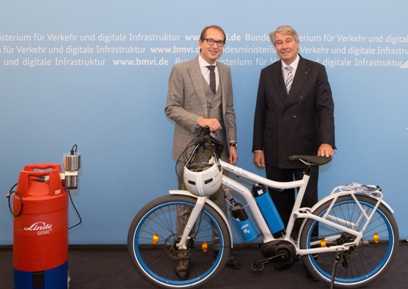The Linde Group of Munich, Germany unveiled a pedelec bicycle Oct. 13 that uses a fuel cell that generates electric power from hydrogen and oxygen taken from the surrounding air.
Linde Group, which has been pioneering the construction of a hydrogen infrastructure for years, claims the zero-emissions drive system supports assisted pedaling over a range in excess of 100 kilometers with a single, 34-gram cylinder of hydrogen. The specially developed fueling system means the cylinder can be refilled in less than six minutes.
“Linde is also pushing new and unconventional ideas to contribute to the widespread commercialization of hydrogen as a clean technology,” commented Dr Wolfgang Büchele, CEO of Linde AG. “With the Linde H2 bike, we have shown that the benefits of hydrogen drives are not restricted to cars – bikes are another interesting application.”
On Tuesday, Büchele
 |
| German Transport Minister Alexander Dobrindt (left) receives a Linde H2 bike from Linde-CEO Dr Büchele |
delivered a Linde H2 bike to German Transport Minister Alexander Dobrindt.
It took Linde engineers less than three months to develop the project from the initial idea to a functioning prototype. Under the motto “I run on hydrogen”, the Linde H2 bike proves that there is a viable alternative to conventional batteries in electric bikes, thus further increasing the appeal of what is already viewed as an environmentally friendly mode of transport.
Like hydrogen-powered cars, fuel-cell bikes have the dual advantage of a long range and a short refueling window of just a few minutes. What is more, they eliminate the need for traction batteries, which come with a limited lifespan and are difficult to dispose of.
The H2 bike, which Linde will produce as a limited prototype series, runs on sustainable green hydrogen fuel. The hydrogen can be obtained through the electrolysis of water using wind energy or by reforming biogas. The carbon balance of the Linde H2 bike is therefore significantly lower than that of a pedelec where the battery is charged using power of mixed sources drawn from the German energy grid.
In the past, Linde has proven its technology leadership with developments such as the ionic compressor – an innovative compressor concept enabling state-of-the-art hydrogen fueling stations.
Having set up approximately 100 hydrogen fueling stations in 15 countries and having successfully completed more than one million refueling operations, Linde is leading the way in H2 infrastructure development. Linde is a founding partner in the recently established joint venture H2 MOBILITY Deutschland GmbH & Co. KG. With several auto manufacturers currently ramping up to series production, Linde is thus laying important groundwork for the successful roll-out of fuel-cell vehicles.
In its last fiscal year, The Linde Group generated revenue of EUR 17.047 billion, making it the largest gases and engineering company in the world with approximately 65,500 employees working in more than 100 countries worldwide. The strategy of The Linde Group is geared towards long-term, profitable growth and focuses on the expansion of its international business with forward-looking products and services.















